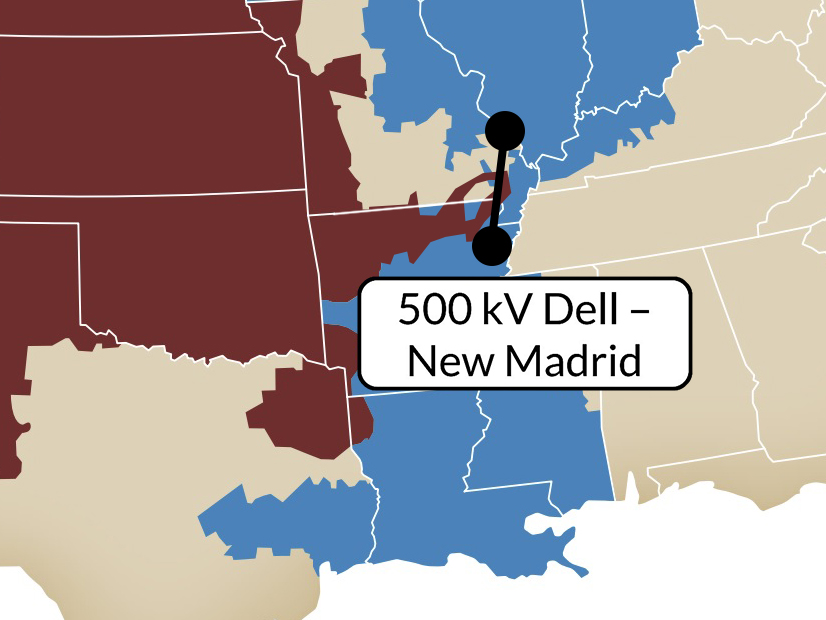
MISO said last week that the transmission line linking its Midwest and South regions has been out of commission since December and is expected to remain offline until July, raising the cost of energy transfers.
The RTO said it will replace the contract path capability between its regions with non-firm service on April 10 until the line returns to service. It said members should prepare for “financial and operational implications.”
The 1,000-MW contract path, a 500-kV Associated Electric Cooperative Inc. line, went offline Dec. 10. The line, which stretches from southern Missouri into northern Arkansas, is MISO’s only physical tie between its Midwest and South regions. MISO said it expects the line to remain on an extended outage through June 30, leaving it dependent on non-firm transfers from neighboring grids.
During a Thursday Market Subcommittee meeting, senior adviser Jack Dannis said a Dec. 10-11 tornado outbreak that bombarded the central and southern U.S. took out 17 towers and four miles of the line. He did not specify which state the line damage occurred in.
The tie was originally expected to be back in service by the end of February. Dannis said he couldn’t speculate on whether the work requiring the outage would be extended beyond June.
Clean Grid Alliance’s Natalie McIntire said she was surprised that MISO waited so long to report the status of the contract path.
“This happened in December, and the first I heard about it … was yesterday,” she said. “I’m wondering why MISO hasn’t alerted stakeholders to this beforehand.”
McIntire pointed out that the grid operator’s leadership has delivered two executive updates to stakeholders since the line went down. Neither mentioned the line’s outage.
As a rule, MISO doesn’t reveal specific generation or transmission outages on its system.
Andy Kowalczyk, with activist group 350 New Orleans, said he was also concerned that staff didn’t communicate the significant outage, especially considering that a winter storm passed through the area a few weeks later.
Dannis said MISO only recently became aware of the outage’s extension into summer. He said the RTO will replace the firm capacity with “non-firm, as available” transmission capacity after it exhausts its four-month grace period, according to a usage agreement of the line with SPP, AECI and other joint parties. The agreement provides that the grid operator can pay an additional $667/MW-month “for every decreased megawatt of contract path capacity.”
Assuming the line is back in service by July, MISO would need to pay about $1.3 million to secure 1,000 MW of non-firm transfer capability. It will divide the cost among market participants using its current market-based allocation design that assigns costs based on excess congestion across its regional directional transfer constraint.
Kevin Vannoy, director of market design, said though MISO’s usual 1,000-MW contract path becomes non-firm because the physical line is out of service, it can still flow up to its usual 2,500-3,000 MW non-firm transfers under its agreement with SPP and the joint parties.
“We think there’s enough physical transfer capability on the system to continue operating as we normally have,” he told stakeholders.
However, Vannoy said it’s possible that conditions might force MISO to order transmission loading relief to reduce transfers. The RTO’s use of non-firm transfers can be curtailed down to zero to prevent load shedding or during system emergencies.
Minnesota Public Utilities Commission staffer Hwikwon Ham asked whether MISO has considered a hypothetical heat wave striking it and SPP at the same time, forcing transfers to be curtailed.
Staff said they’re increasing coordination with members but haven’t devised any special mitigation plans.
Stakeholders questioned why MISO didn’t make updates to either its spring reliability outlook or the delivery estimates in its capacity auction because of a major transmission line’s loss.
Dannis said MISO has been operating for three months now with “minimal” operational impacts. He said he expects little difficulty during the shoulder maintenance season.
MISO Director of Settlements Laura Rauch said the impacts should be strictly financial.
“We can still operate as we normally do. This is about dollars, not anything that would preclude us from operating,” she said.
Stakeholders asked why it’s taking six months to complete line repairs.
Dannis said he was aware of some supply chain issues for equipment needed to fix the line but said he couldn’t offer anything further.



